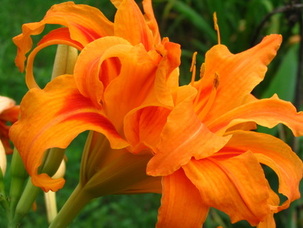
The daylily is a monocot related to Orchids, Hostas and Grasses. They were originally thought to be in the the Lily family (Liliaceae) but are now placed in their own family Hemerocallidaceae and are in the genus Hemerocallis. Although they're sometimes thought of a native wild flower (and a somewhat invasive one), they are actually a long-ago transplant from Asia. Daylily species were recorded centuries ago in Manchuria, Mongolia, Northern India as well as throughout China, Japan and Korea. In their natural habitat they are found in swamps, seashore meadows, forests edges and on mountains up to 10,000 feet. They spread to Western Europe in the middle ages and were brought to North America by early English settlers in the early eighteenth century. By the late nineteenth century they had become ubiquitous in the US and were given a myriad of common dames from Tiger Lilies, Railroad Lilies, Roadside Lilies, and even Outhouse Lilies.
While there was some hybridizing of daylilies in the early 1900's however it wasn't until a Dr Stout began hybridizing and identifying the species in the 1930's that they really took off. Today they are almost as popular as roses, and the 20 original cultivars have grown to over 45,000 recorded varieties.
Both the buds and the blossoms of day lilies are edible. It's best to choose smallish buds that are just beginning to open and cook them as you would fresh beans -- either steamed or sauteed in olive oil and added chilled to salads or served hot as a side dish. Daylily buds will keep in the refrigerator for several days, but the flowers are more delicate and should be consumed the same day they are picked. You can add the petals to egg dishes, soups and salads, or dip whole flowers in batter and deep-fry them as you would squash blossoms.
 RSS Feed
RSS Feed
